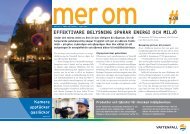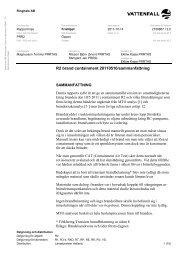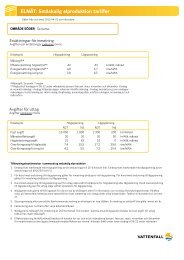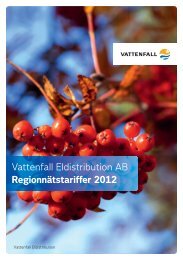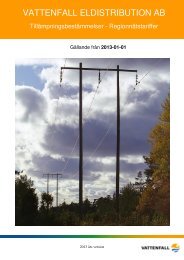This environmental impact assessment for Kriegers flak ... - Vattenfall
This environmental impact assessment for Kriegers flak ... - Vattenfall
This environmental impact assessment for Kriegers flak ... - Vattenfall
You also want an ePaper? Increase the reach of your titles
YUMPU automatically turns print PDFs into web optimized ePapers that Google loves.
102 PRESENTATION OF THE AREA<br />
tion with studies of staging birds at <strong>Kriegers</strong> Flak.<br />
These investigations ran <strong>for</strong> two years between<br />
April 2002 and March 2004. An area of 505km² was<br />
surveyed from ships at 35 occasions with a distance of<br />
four km between the transections. Mammals have also<br />
been surveyed by aeroplanes 21 times within an area of<br />
560 km2, with a distance of two km between transactions.<br />
In order to register possible existence of porpoises,<br />
click-detectors of the type T-POD were at 15 occasions<br />
positioned between one to three days from an anchored<br />
ship during a total of 36 days.<br />
During the whole period only three porpoises and<br />
three grey seals were observed at <strong>Kriegers</strong> Flak. No<br />
harbour seals were observed during the two year long<br />
survey.<br />
An extensive literature study of grey seal, harbour<br />
seal and porpoises has been made in connection with<br />
the above study by IfAÖ and the result thereof, together<br />
with the investigations, are presented below.<br />
11.6.5.1 Grey Seal<br />
The grey seal is the biggest of the Swedish seal species.<br />
It can reach three metres and weigh 300 kg. Females<br />
are smaller than the males and can reach a length of<br />
2 metres and weigh up to 200 kg. The grey seal gives<br />
a grey impression with a lighter belly. The proÞ le of<br />
the head is the most distinct feature in comparison<br />
with other seals, with a straight line from head to nose,<br />
which is quite long. The grey seal reaches an age of<br />
25-35 years in wild conditions and up to 40 years in<br />
captivity.<br />
The natural habitat of the grey seal is concentrated<br />
to the north-eastern Baltic and at the beginning of the<br />
20th century there were about 100 000 in the area.<br />
Since the grey seal competes with the Þ shermen <strong>for</strong><br />
Þ sh, it was pursued early on and the numbers declined<br />
rapidly. In the middle of the 1980s’ the total number<br />
was estimated to 1 500 individuals. The population<br />
thereafter increased largely and was 7500 individuals<br />
in 1999 (Sundberg & Söderman 1999). The population<br />
along the Swedish south coast, Skåne, Småland<br />
and Gotland, is estimated to 200 individuals (Helander<br />
& Häkönen). At Falsterbo, there is a population of<br />
grey seals, which was counted from land in 1996 and<br />
estimated to 50 animals (Tielman & Heide-Jörgensen<br />
2001).<br />
In Danish waters 12 grey seals were observed during<br />
2000 at Rödsand (Tielman & Heide-Jörgensen<br />
2001). During the autumn 2000, also grey seal cubs<br />
were identiÞ ed. It is unclear if they stem from Rödsand<br />
or Falsterbo.<br />
In 1990 grey seals had a resting place at Saltholm<br />
in Öresund but when counting from the air in 2000, no<br />
seals could be detected (Tielman & Heide-Jörgensen<br />
2001).<br />
Along the German Baltic coast there are no colonies<br />
or resting places of grey seal as the grey seal was<br />
extinguished in Germany during the 1920’s.<br />
By monitoring grey seals with an implanted satellite<br />
transmitter, it has been possible to conÞ rm that 95%<br />
of grey seals move within an area with a radius of<br />
36–196 km from the resting place at the western tip of<br />
Rödsand, see red markings in the Þ gure on page 101.<br />
The grey seal wanders in the Baltic were it regularly<br />
crosses the Arcona Basin and is there<strong>for</strong>e assumed to<br />
move in the waters at <strong>Kriegers</strong> Flak. The three observed<br />
grey seals at <strong>Kriegers</strong> Flak probably belong to<br />
the population based at Falsterbo since this is closer to<br />
<strong>Kriegers</strong> Flak than Rödsand.<br />
Grey seal uses areas close to the cost as well as<br />
areas further out at sea <strong>for</strong> locating food. <strong>Kriegers</strong> Flak<br />
could potentially be a food retrieving area <strong>for</strong> seals<br />
from Falsterbo but as so few seals have been spotted<br />
there, it is not very likely. The reason <strong>for</strong> this is probably<br />
the intense trafÞ c in the area around <strong>Kriegers</strong><br />
Flak (60 000 ships a year, Þ shing and leisure boats not<br />
included).





